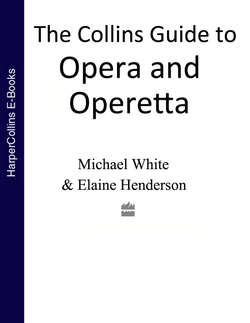Читать книгу The Collins Guide To Opera And Operetta - Michael White - Страница 29
ОглавлениеFORM: Opera in two acts; in English
COMPOSER: Harrison Birtwistle (1934– )
LIBRETTO: David Harsent; from an anonymous 14th-century poem
FIRST PERFORMANCE: London, 30 May 1991
Principal Characters
Gawain, a knight and King Arthur’s nephew Baritone
Morgan le Fay, a sorceress Soprano
Green Knight/Bertilak Bass
Lady de Hautdesert, Bertilak’s wife Mezzo-soprano
Synopsis of the Plot
Setting: Arthurian Britain
ACT I While Arthur and his court are celebrating Christmas, the sorceress, Morgan le Fay, and her accomplice, Lady de Hautdesert, plan to undermine the court’s complacency and self-regard. The king is bored. Morgan le Fay promises him excitement. At that moment a mysterious Green Knight arrives with a challenge: he will allow himself to be beheaded but the knight who does the deed must present himself at the Green Chapel in a year and a day, and submit to a similar blow. Gawain accepts the challenge; he decapitates the Green Knight who, to everyone’s amazement, gets up and leaves with his head under his arm. The act concludes with a masque during which Gawain is prepared, spiritually, for his journey to the Green Chapel and his potentially fatal meeting with the Green Knight.
ACT II Gawain, on his way to the Green Chapel, finds shelter in the castle of Bertilak de Hautdesert. Bertilak issues him with another challenge: he will hunt for three days and exchange all he has caught for what Gawain can acquire in the castle. Spurred on by Morgan le Fay, Lady de Hautdesert tries to seduce Gawain while her husband is away. She gives him a sash with magical properties to protect him from death; he keeps it for his forthcoming confrontation with the Green Knight. Gawain is struck three times by the Knight, but is only grazed, and the Knight reveals himself to be Gawain’s host, Bertilak de Hautdesert. Gawain returns to Arthur’s court to be greeted as a hero. But knowing the truth to be otherwise – that he only survived the ordeal through the magic of the sash – he rejects the court’s empty praise and demands for tales of bravery and valour. The collective morale of the Round Table is punctured, and Morgan le Fay, who plotted all this, rejoices in her victory.
Music and Background
It’s no use pretending that this is easy listening. It isn’t; and the orchestral textures are so Wagnerian in scale and weight that you have to pay very careful attention to catch any of the words in performance. There are times when the whole score seems like a great machine grinding relentlessly away in an unbroken flow of (very noisy) sound. But repeated listening helps to sort out what’s going on – as is the case with any opera – and reveals the poetry within the punishment. Otherwise, Gawain packs a massive punch on stage; and the ritual theatre of the turning of the seasons at the end of Act I is a good example of the cyclic, ceremonial preoccupations of the composer.
Highlights
The arrival of the Green Knight on what Birtwistle calls a ‘noble pantomime horse’ is bizarre but breathtaking: you hear clip-clopping noises from the orchestra and in any other circumstance they might make you laugh. But not here. The effect is spine-tingling and awesome. For an example of how memorably melodic Birtwistle can be when he chooses, try Gawain’s repeated cries of ‘I’m not that hero’ in the final scene.
Did You Know?
Many commentators consider Gawain one of the supreme achievements of late 20th-century opera.
Recommended Recording
Francois Le Roux, John Tomlinson, Marie Angel, Royal Opera, Covent Garden/Elgar Howarth. Collins Classics 7041-2. The only recording, taken live from the Covent Garden performances.
